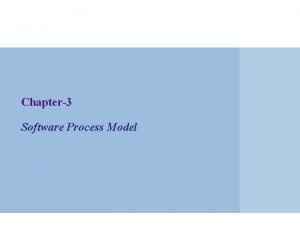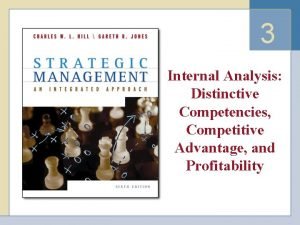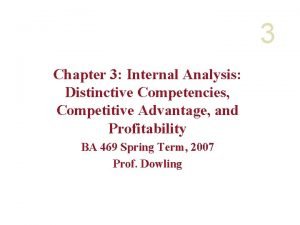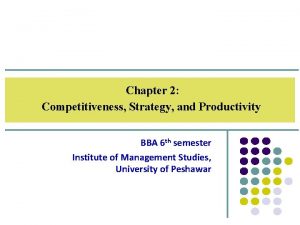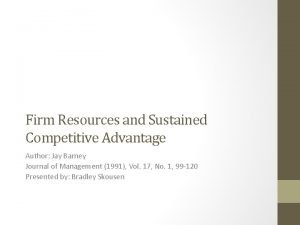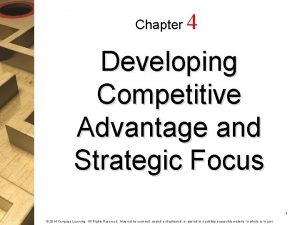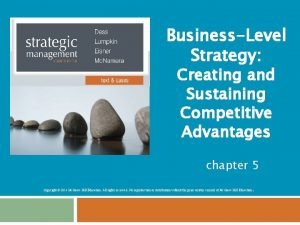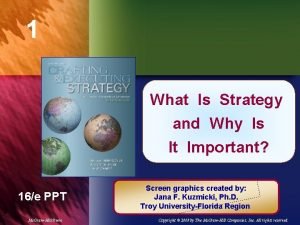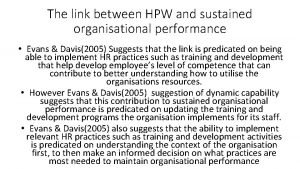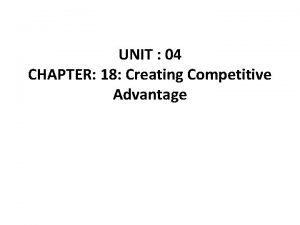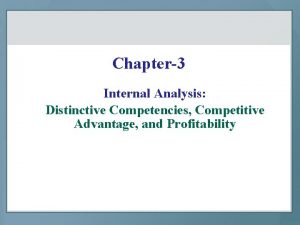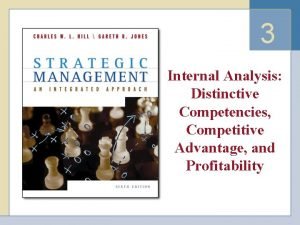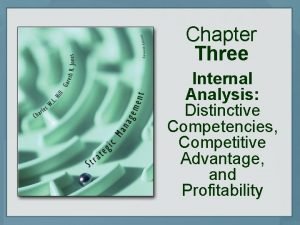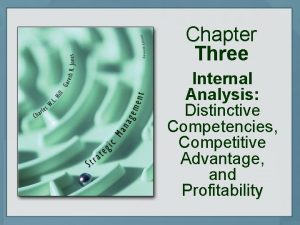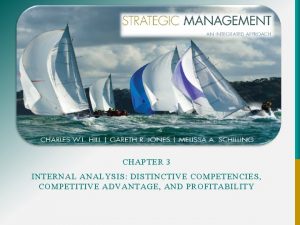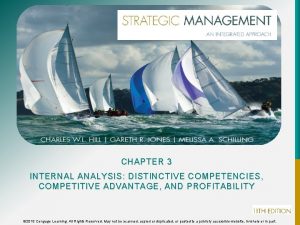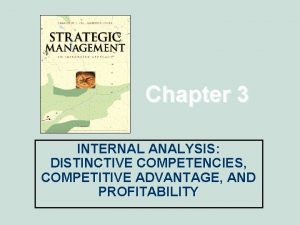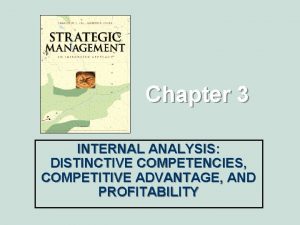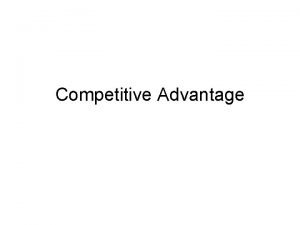Chapter3 Internal Analysis Distinctive Competencies Competitive Advantage and













- Slides: 13

Chapter-3 Internal Analysis: Distinctive Competencies, Competitive Advantage, and Profitability

Lesson Learning Objective The students will be able to understand about four building blocks and durability of competitive advantages. They also know about sustained competitive advantages and why company fail?

Lesson Contents: 1. Building Blocks of Competitive Advantage 2. Efficiency 3. Quality 4. Innovation 5. Responsiveness to Customers 6. Analyzing Competitive Advantage and Profitability 7. The Durability of Competitive Advantage 8. Why Companies Fail? 9. Avoiding Failure: Sustaining Competitive Advantage

Building Blocks of Competitive Advantage The Generic Distinctive Competencies Allow a company to: ü Differentiate product offering ü Offer more utility to customer ü Lower the cost structure regardless of the industry, its products, or its services

Efficiency Measured by the quantity of inputs it takes to produce a given output: Efficiency = Outputs / Inputs Productivity leads to greater efficiency and lower costs: ü Employee productivity ü Capital productivity Superior efficiency helps a company attain a competitive advantage through a lower cost structure.

Quality products are goods and services that are: ü Reliable and ü Differentiated by attributes that customers perceive to have higher value The impact of quality on competitive advantage: ü High-quality products differentiate and increase the value of the products in customers’ eyes. ü Greater efficiency and lower unit costs are associated with reliable products. Superior quality = customer perception of greater value in a product’s attributes Form, features, performance, durability, reliability, style, design

Innovation is the act of creating new products or new processes. Product innovation üCreates products that customers perceive as more valuable and üIncreases the company’s pricing options Process innovation Creates value by lowering production costs Successful innovation can be a major source of competitive advantage – by giving a company something unique, something its competitors lack.

Responsiveness to Customers Identifying and satisfying customers’ needs – better than the competitors ü Superior quality and innovation are integral to superior responsiveness to customers. ü Customizing goods and services to the unique demands of individual customers or customer groups. üEnhanced customer responsiveness Customer response time, design, service, after-sales service and support Superior responsiveness to customers differentiates a company’s products and services and leads to brand loyalty and premium pricing.

Analyzing Competitive Advantage and Profitability v Competitive Advantage • When a companies profitability is greater than the average of all other companies in the same industry that compete for the same customers v Benchmarking • Comparing company performance against that of competitors and the company’s historic performance v Measures of Profitability üReturn On Invested Capital (ROIC): • ROIC = Net profit Capital invested = Net income after tax Equity + Debt to creditors üNet Profit : Net Profit = Total revenues – Total costs

The Durability of Competitive Advantage The durability of a company’s competitive advantage over its competitors depends on: Barriers to Imitation: Making it difficult to copy a company’s distinctive competencies ü Imitating Resources ü Imitating Capabilities Capability of Competitors: ü Strategic commitment Commitment to a particular way of doing business ü Absorptive capacity Ability to identify, value, assimilate, and use knowledge Industry Dynamism: Ability of an industry to change rapidly Competitors are also seeking to develop distinctive competencies that will give them a competitive edge.

Why Companies Fail? Inertia: ü Companies find it difficult to change their strategies and structures Prior Strategic Commitments: ü Limit a company’s ability to imitate and cause competitive disadvantage The Icarus Paradox: ü A company can become so specialized and inner directed based on past success that it loses sight of market realities ü Categories of rising and falling companies: • Craftsmen • Builders • Pioneers • Salespeople ü When a company loses its competitive advantage, ü its profitability falls below that of the industry. ü It loses the ability to attract and generate resources. Profit margins and invested capital shrink rapidly.

Avoiding Failure: Sustaining Competitive Advantage Focus on the Building Blocks of Competitive Advantage: ü Develop distinctive competencies and superior performance in: v Efficiency Quality v Innovation Responsiveness to Customers Institute Continuous Improvement and Learning: ü Recognize the importance of continuous learning within the organization Track Best Practices and Use Benchmarking: ü Measure against the products and practices of the most efficient global competitors Overcome Inertia: ü Overcome the internal forces that are barriers to change Luck may play a role in success, so always exploit a lucky break - but remember: “The harder I work, the luckier I seem to get. ” J P Morgan

Thank you for you nice cooperation Any Question? ? ?
 What is incremental process model
What is incremental process model Chapter3
Chapter3 Distinctive competencies
Distinctive competencies Distinctive competencies
Distinctive competencies Quality-based strategy examples
Quality-based strategy examples Pharmacology introduction
Pharmacology introduction Slow-cycle market companies examples
Slow-cycle market companies examples Least competitive market
Least competitive market Firm resources and sustained competitive advantage
Firm resources and sustained competitive advantage Developing competitive advantage and strategic focus
Developing competitive advantage and strategic focus Porters 3 generic strategy
Porters 3 generic strategy A company's strategy can be considered ethical
A company's strategy can be considered ethical Sustainable organisation performance cipd
Sustainable organisation performance cipd Chapter 18 creating competitive advantage
Chapter 18 creating competitive advantage
